
|   |

|   |
Natya Dasoham, Nritya Tarang & a mesmerizing Bharatanatyam duet - Satish Suri e-mail:satishism@yahoo.co.in November 5, 2023 NATYA DASOHAM: AN ODE TO HARIDASA SAHITYA Photos:Nrityaangan Natya Dasoham took place on 2nd October at Pathi Sabhangana, Bangalore, and was a collaboration between Nrityaankur in Bengaluru and Nrityaangan in Mangaluru. The production explores the various aspects of Haridasa Sahitya in the Bharatanatyam format, such as its philosophy, aesthetics, musicality and spirituality to bring out the essence and beauty of the Haridasa compositions. Eight artistes performed seven compositions selected by them individually. The selection of Shreepada Rayara's composition "Elladu bande muddu Rangayya" in Charukesi raga for Radhika Shetty's performance demonstrates the artistic excellence and thematic richness of the presentation. The composition aptly captures the essence of vatsalya bhava, the emotional bond between a mother and child. In this context, the mother's inquiry about little Krishna's location and her thorough search in all directions add an element of emotional depth and relatability to the performance. Radhika Shetty's performance skillfully captured the heartwarming essence of a mother's love and concern for her playful child. 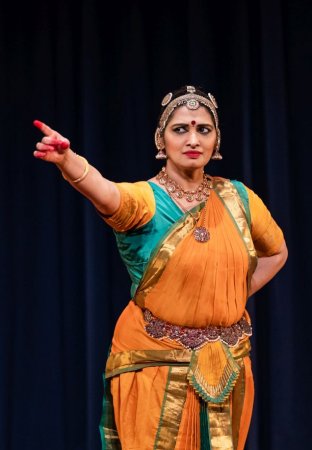 Radhika Shetty 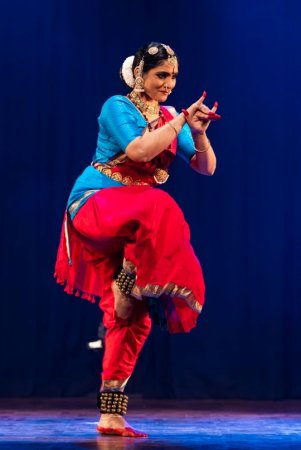 Manjula Subrahmanya Vyasaraya's composition eloquently expresses the value of human birth and its spiritual potential. It acknowledges the fact that human beings often sin, both knowingly and unknowingly, but also affirms the faith that Lord Krishna, through his divine deeds and leelas, restores dharma and grants moksha to his devotees. This composition resonates with the broader themes prevalent in many spiritual and philosophical traditions, which stress the importance of self-awareness, repentance, and the pursuit of dharma. It implies that despite human weaknesses and mistakes, there is a possibility for spiritual progress and liberation through bhakti and the mercy of the divine. The notion of Sanchita karma, which denotes the accumulated karma from past actions, is also a crucial aspect of many spiritual teachings. The composition conveys the idea that Lord Krishna is the supreme saviour who can help individuals overcome the effects of their past karma through devotion and surrender. Manjula Subrahmanya brought out the essence of the piece with her mastery of the dance form, moving with grace and fluidity, transitioning smoothly between different steps, postures and expressions. She performed not just with skill but with depth, emotion, and purpose, showcasing her virtuosity as an artiste. Vadiraja composed many beautiful songs in praise of Lord Krishna. One such composition is "Aala maganendu ariyave", which means 'Do you know who this boy is?' In this song, he portrays the charming and mischievous antics of little Krishna, who captivates the hearts of the gopis with his divine love. The song narrates a conversation between two gopis, who boast about their intimate relationship with Krishna and express their wonder at his amazing feats. They also reveal their state of "atma nivedana" or total surrender of themselves to Krishna, which is the highest form of devotion according to the Dvaita philosophy. The song showcases Vadiraja's poetic genius and spiritual insight. The choreography was executed with expertise and grace by Sharadamani Sekhar and Rajashree Shenoy, who created smooth and seamless transitions that enhanced the fluidity and beauty of the performance, conveying the emotional and spiritual nuances of the composition effectively. Their performance was not just a technical display, but a purposeful expression of the spiritual richness of the composition. They created a lasting impact on the audience with their proficiency and grace.  Sharadamani Sekhar and Rajashree Shenoy  Unnath Jain Unnath Jain's dramatization of Purandara Dasa's composition "Sharanu sakaloddhara asura kula samhara" set in Ragamalika was a powerful and emotionally resonant performance. The composition itself is a deeply bhakti-oriented one, celebrating the glory of Sri Rama and describing various aspects of his divine persona. The depiction of Rama's graceful countenance, his resplendent ornamentation, and his symbolic bow, as described in the composition, added a visual dimension to the performance. The portrayal of Shabari, an important character in the Ramayana, and her interaction with Rama is a poignant moment in the narrative. The way she offers berries to Rama, the physical posture of an old lady filled with tears, her humility, and her adoration are powerful symbols of devotion and selflessness. Unnath Jain's rendition captured these elements with vividness, bringing out the serenity and humility that characterize Shabari's character. Manjari Chandra Pushparaj's performance defined her perspective of Kanakadasa's journey to Udupi to meet Lord Krishna and the events surrounding it through three compositions. "Krishna nee maaye ollago" portrays Kanakadasa's deep yearning and devotion to Lord Krishna. The lyrics express a personal and profound connection with the divine, and Manjari's interpretation conveyed the intensity of this devotion. "Bajisi bathakelo" depicted the act of seeking the divine through devotion and surrender. Kanakadasa's journey to meet Lord Krishna at the Udupi temple is a central theme, and the performance conveyed the anticipation and devotion involved in this pilgrimage. "Bagilanu teradu" and "Baro Krishnayya dasa ninna pada dasa" represent a significant moment in Kanakadasa's life when he was denied entry into the temple due to social norms and prejudice. His devotion and longing to have a direct glimpse of Lord Krishna are conveyed through these compositions. Manjari's performance was marked by impressive expressions and characterizations. These aspects are vital in conveying the sentiments of devotion, yearning, and the profound connection between the devotee and the divine, which are central themes in Kanakadasa's compositions. Vijaya Dasa's composition "Saagi Barayya" depicting the glory of the Brahmotsavam at Tirumala is both intriguing and spiritually resonant. This composition narrates a particular episode during the grand procession where the chariot, a central element in the festival, refuses to move despite numerous attempts. Vijaya Dasa's pleas to Lord Venkateswara, the presiding deity of Tirumala, are met with divine intervention, and the chariot begins to move. This episode holds deep religious and symbolic significance, portraying the divine power and responsiveness of the deity to the sincere prayers and dedication of the devotees. Sagar TS's performance invested the narrative with intensity, conveying the urgency and fervour of Vijaya Dasa's pleas and the subsequent joy and relief of the devotees as the chariot began to move. The use of delightful visual frames and strong techniques added to the overall visual and emotional impact of the performance.  Sagar TS "Baala ramya vagide Hariyu mancha" is a devotional composition by Jagannatha Dasa as a tribute to Lord Narayana, the preserver of the universe. The composition describes the sublime beauty and splendour of Lord Narayana as he lies on the serpent bed, Adisesha, which represents his cosmic power and wisdom and also expresses the devotion and admiration of the poet for the divine lord, and his desire to attain his grace and blessings. The composition is a part of Hindu devotional literature and music tradition, which aims to evoke a sense of spiritual connection and transcendence among the devotees. Vidyashree Radhakrishna skillfully blended various elements of mythology, philosophy and aesthetics, creating a dynamic and immersive presentation. She portrayed the three doors of the Anantapadmanabha temple, each representing a different aspect of the divine. She dramatized the episode of Lakshmana defeating Indrajit, the son of Ravana, from the Ramayana, displaying the courage and valour of Lakshmana, as well as the cunning and deception of Indrajit. She expressed the vatsalya bhava of Balarama towards his brother Krishna. Vidyashree concluded the performance with the depiction of Lord Vishnu as Jagannatha, lying on Adisesha. She conveyed the tranquillity and majesty of Lord Vishnu in this form, as well as his role as the protector of the universe. The performance was a feast for the eyes and ears, with expressive gestures, intricate footwork, and rhythmic music. Vidyashree's talent as a performer shone through, as she delivered a memorable and inspiring program. 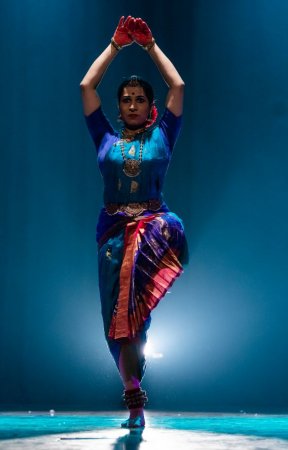 Vidyashree Radhakrishna The performance of Haridasa Sahitya was enriched by the unique choreographies and renditions of the artistes who presented it. Nanda Kumar Unnikrishnan sang the compositions with passion and skill, creating a lively atmosphere. The musical accompaniment was excellent, with Karthik Vydathri on the mrindagam, Nitish Ammanayya on the flute, and Sumangala Ratnakar on the nattuvangam. NRITYA TARANG BY AMRITA LAHIRI Kalavaahini's 'All for Dance' series curated by Malavika Sarukkai, showcased a sparkling Kuchipudi performance by Amrita Lahiri at the Bangalore International Centre on the 12th of October. The event was organized in association with Shreya Nagarajan Singh Arts Development Consultancy. Amrita Lahiri displayed grace and agility, enthralling the audience with her intricate footwork, fluid movements and dramatic storytelling. The opening "Vani Paraku" set the tone for the performance by Amrita, who sought the blessings of the Goddess of learning before presenting her dance. She then performed "Kamakshi Stuti" that depicts the Goddess Kamakshi in all her splendour, highlighting her beauty, strength, power and kindness. It is a piece that conveys devotion and respect for the supreme feminine power. The choreography by Vempati Chinna Satyam skillfully captured the essence of the Goddess and her qualities through refined movements and expressions. 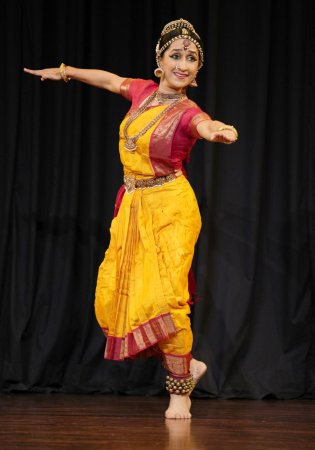 Amrita Lahiri (Photo: Prof K.S. Krishnamurthy) Amrita's performance of the kalapam from Usha Parinayam, which she learned under Swapna Sundari, was a powerful and emotionally charged portrayal of the story. The kalapam revolves around the story of Banasura's daughter, a young and beautiful woman with unfulfilled desires. Her dream of a prince embracing her and making love to her stirs strong emotions within her. The piece includes a dramatic monologue where the character expresses her inner turmoil. The line "idi emo telupave" reflects her overwhelming emotions and the need to confide in her friend Chitralekha to help her. Amrita's performance focused on the Pravesha Daravu, a key element in Kuchipudi dance that signifies the entry of a character. The inclusion of vibrant rhythmic sequences reflects the dynamic and rhythmic aspect of Kuchipudi. The lively combination of nritya and natya was executed with finesse, highlighting Amrita's skill and proficiency in both the technical and expressive aspects of Kuchipudi. Deviating from the traditional tarangam of the Kuchipudi repertoire, Amrita performed a Javali "Smarasundaranguni" in Paras raga, a piece that she learnt from Leela Samson. She portrayed the nayika who praises her beloved for his good looks and loyalty. She expressed her gratitude for his attentive and faithful nature, never looking at another woman. Amrita's performance was full of bhava. She showed both power and elegance in her movements, bringing out the meaning of the lyrics. The program culminated with a Thillana in raag Behag, a piece composed by Dr. Balamuralikrishna and choreographed by her Guru Jaikishore Mosalikanti. Amrita's performance was marked by artistic skill, remarkable elegance, and undeniable grace. The dance was visually captivating, and the soundscape enhanced its appeal. The vocals by Sujesh Menon, violin by Mangala Vaidyanathan, nattuvangam by Kaleeswaran Pillai and mridangam by Satish Krishnamurthy created a harmonious blend of music and rhythm that complemented the dance. MESMERISING BHARATANATYAM DUET BY POOJA DESAI AND SHRUTI DOSS A captivating performance of Bharatanatyam by Pooja Desai and Shruti Doss, senior students of Guru Praveen Kumar, took place at the Seva Sadan, Bangalore, on the 13th of October. The dancers started with an Alarippu in mishra chapu tala, which incorporated two Sanskrit verses that honoured Mother Earth and sought her blessings and protection. The artistes displayed their rhythmic skills and grace in this piece. The Swarajathi performed by Pooja Desai and Shruti Doss in the Khamas raga, titled "Sambasivayanave" is a remarkable and devout piece. This composition by Chinna Krishna Dasar comprises a pallavi, anupallavi, and five charanas (stanzas). The lyrics convey deep devotion and respect for Lord Shiva, depicting his merciful and loving nature. The devotee contemplates the divine form of Lord Shiva, considering him both their God and Guru. The composition incorporates sancharis related to Markandeya and Tripura Samhara. Markandeya is a young sage who is known for his devotion to Lord Shiva, and Tripura Samhara is the divine act of Shiva destroying the three demon cities.  Pooja Desai and Shruti Doss (Photo: Madhukar) The artistes displayed scintillating synchrony and visual appeal with the creative choreography by Guru Praveen Kumar. The composition offered a rich canvas for exploring the interplay of rhythm and movement that was executed with precision and flair. Overall it was a visually stunning and artistically rich presentation. Pooja Desai's solo presentation of a Padam "Ellam ariven pomaiya", a composition of Kavi Kunjara Bharati in Kalyani raga, depicts a nayika confronting her Lord Subramanya, for what she considers dishonest behaviour. She expresses her dissatisfaction and mistrust about the Lord's words and actions, implying that she feels betrayed. The jilted nayika's words and feelings convey a sense of anger and resentment, asking how the Lord, who is highly revered by poets and is seen as noble, would act in a way that seems deceitful to her. The piece's thematic focus on a nayika's emotional journey, from devotion to disillusionment, added drama to the performance and demonstrated the artiste's acumen to portray complex emotions. In contrast, Shruti Doss presented the Javali titled "Smarasundarangini" in the Paras raga. The nayika expresses her admiration for her handsome hero, highlighting his qualities as a considerate and devoted partner. She appreciates how her hero caters to her every whim, listens patiently, and remains faithful to her. The artiste's interpretation highlighting the poetic content was a testament to her versatility. The performance of Pooja Desai and Shruti Doss culminated in a dazzling Thillana composed by Madurai N Krishnan in the Simhendramadhyam raga. and was a tribute to Lord Muruga. The raga, which is known for its vitality and joy, gave a festive and upbeat tone to the end of the performance, making it a fitting way to end the program on a high note. The tribute to Lord Muruga shows the devotional aspect of the performance, and the Thillana enabled the artistes to demonstrate their technical skill and creativity joyfully and rhythmically. The exposition was enhanced by the music ensemble, which consisted of Srivatsa on the vocals, Mahesh Swamy on the flute, Vinay Nagarajan on the mridangam and Guru Praveen Kumar on the nattuvangam. The musicians collaborated skillfully, bringing out the best of their talents and creating a captivating musical atmosphere. Guru Praveen Kumar, in particular, played a crucial role as the conductor and facilitator of the performance, ensuring that it was smooth and synchronized. 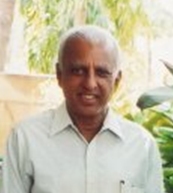 Bangalore based Satish Suri is an avid dance rasika besides being a life member of the Music and Arts Society. |